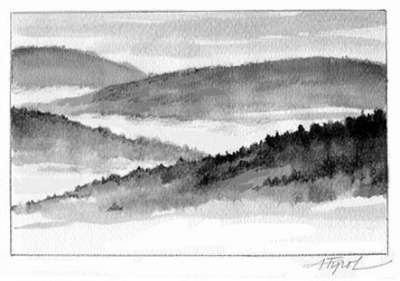
Our organic vegetable farm sits deep in the Connecticut River valley, a few hundred feet above the river and more than a thousand feet below the top of the valley’s walls. On autumn mornings, we are often submerged in a sea of fog; the tide doesn’t recede some days until as late as noon.
We plan our final harvest week of the season to coincide with peak foliage, which is roughly the middle of October where we live. This is not to attract leaf peepers to our farm, which sits at the end of a dirt road, far from the main tourist routes. Rather, it is for the simple reason that foliage prevents frost.
Well, “prevents” may be too strong a word, but it is certainly safe to say that foliage “mitigates” or “reduces the impact of” frost in the deep crevices of the river valleys of New Hampshire and Vermont.
The key link between foliage and frost is fog. Most people believe that the reason we have so much fog in the fall is because the night sky is growing ever colder, causing moisture in the air to condense into fog. This is true. Especially on clear, still nights, when heat from ground level radiates up into the sky, fog banks can grow to hundreds of feet thick by morning. The cold night sky of autumn explains why fog is a fall phenomenon: the night sky of summer is rarely cold enough to turn all that humidity into fog.
But the cold of autumn is only half the story. In November, for example, the sky is even colder than it is in October, yet fog is not very common. Why not? Because there isn’t enough moisture in the air. That’s where the foliage comes into play.
Trees are enormous consumers of water, and nearly all of the water they consume is released through the leaves into the air as part of photosynthesis. Indeed, just over half of all the rain that falls on our forests during the year is taken up by trees and respired into the air. Some very rough back-of-the-envelope calculations: 36 inches of rain falling on the 5 million acres of the Connecticut River valley in a year translates into 15 million acre-feet of water. At 325,000 gallons per acre-foot and 225 days of foliage growth per year, that’s roughly seven billion gallons of water that our forests release into the air over the Connecticut River on a typical day. Give or take a billion. When the leaves are on the trees.
Once the leaves have fallen off, however, this moisture conveyor belt is turned off. Trees are dormant. The seven billion gallons go away. Fog becomes rare.
Another way to recognize this phenomenon is to observe the amount of water flowing in our brooks and streams in the fall. Once the trees lose their leaves, stream flows rise as all those gallons that would have been taken up by the trees find their way into the brooks instead. The ground in November is often soggy underfoot where it was dry in September, even with equivalent amounts of rainfall.
Back on the farm, autumn fog helps protect our crops in three ways. First, thick fog acts like a blanket on clear nights, trapping heat near the ground and shielding tender crops from direct exposure to the night sky. Second, water vapor releases heat into the air as it condenses into fog, and while that heat isn’t enough to overcome a major drop in temperature, it can be enough to keep an overnight low temperature just above freezing rather than just below – a crucial difference to the vegetable grower. Finally, fog helps insure that the crops have plenty of moisture; a well-hydrated plant is better able to avoid frost damage than a desiccated plant.
Once the leaves are down and the fog dries up, our location deep in the river valley works against the growing of crops. Overnight temperatures drop significantly as the cold night air sliding off the hills pools deep in the valley. Our farm, which was warmer than those on the high hilltops during the early autumn, suddenly becomes much colder once the fog is gone. No foliage means no fog; no fog means more frost.
This fall, my final vegetable harvest didn’t coincide with peak foliage. September was exceptionally warm and reasonably wet. By early October, the foliage had barely begun to turn. We had to call it a season anyway, given that we hadn’t planted enough crops to harvest deep into October. But it sure was odd to be gathering in the leeks and Brussels sprouts under blue skies and green leaves, with not a hint of impending frost.

